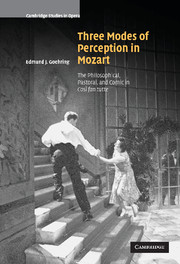Book contents
- Frontmatter
- Contents
- List of tables
- Preface and acknowledgments
- A note on translations
- List of abbreviations
- Chapter 1 An overture to Così fan tutte: the poetics of the opera over two centuries
- Chapter 2 The philosophical mode
- Chapter 3 The pastoral mode
- Chapter 4 The comic mode
- Epilogue
- Bibliography
- Index
Preface and acknowledgments
Published online by Cambridge University Press: 22 September 2009
- Frontmatter
- Contents
- List of tables
- Preface and acknowledgments
- A note on translations
- List of abbreviations
- Chapter 1 An overture to Così fan tutte: the poetics of the opera over two centuries
- Chapter 2 The philosophical mode
- Chapter 3 The pastoral mode
- Chapter 4 The comic mode
- Epilogue
- Bibliography
- Index
Summary
Encounters with Così fan tutte usually leave the listener with basic questions. What is Don Alfonso up to when he sings “Vorrei dir?” Why does he participate in “Soave sia il vento?” Fiordiligi falls in love with Ferrando in the second act (or is it with his alter ego, Sempronio?); does Ferrando fall in love with her? How can the singer of the funereal “Smanie implacabili” be the same one who later insists, with elation, that love is a little serpent? (Peter Sellars, in dropping Dorabella's second-act aria, implies that the two Dorabellas cannot be the same.) And is the reconciliation at the end of the opera more scribbled on paper than inscribed onto the hearts of the dramatis personae?
It would be easy enough to cut the Gordian knot by declaring the work incoherent or sinister. Both verdicts have settled deeply into thinking about the opera over its reception history. In theory, they make two incompatible claims: the former faults Così fan tutte for being a pastiche rather than a proper work of art; the latter cedes a purpose to the opera but identifies in it a cynical outlook born of myopia. In practice, these two long-lived objections usually come as a pair. The opera is said to fail as a coherent work of art because, finally, it promotes an untenable view of human nature.
- Type
- Chapter
- Information
- Three Modes of Perception in MozartThe Philosophical, Pastoral, and Comic in Cosí fan tutte, pp. xiii - xviPublisher: Cambridge University PressPrint publication year: 2004



